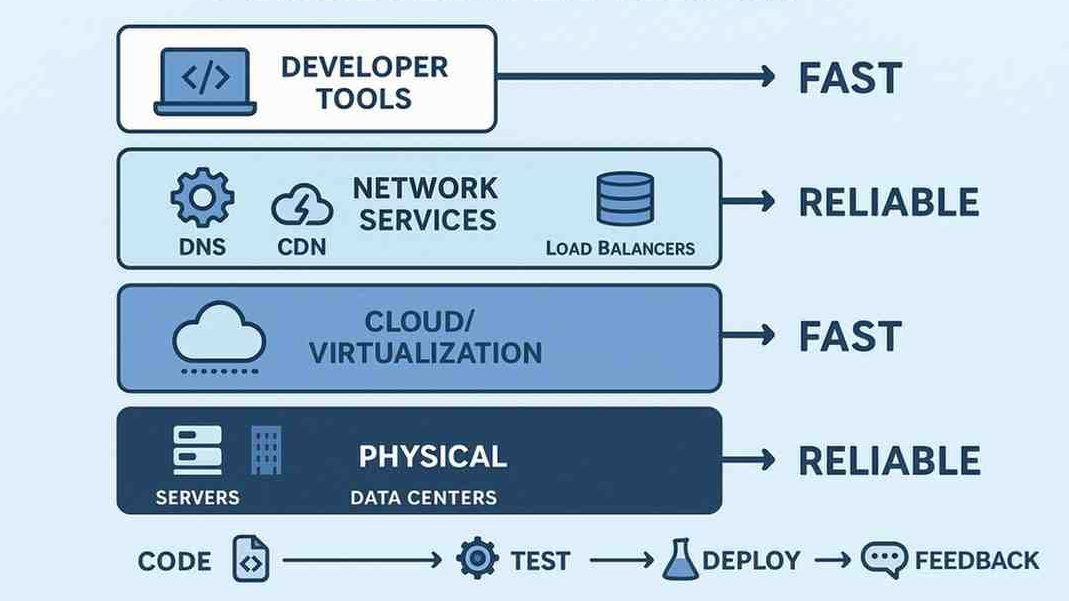Future-Proofing Your Tech Stack
In a fast-scaling software environment, your technical infrastructure must evolve just as quickly as your product. What starts as a lean stack for a three-person startup can soon become a bottleneck once you’re handling API calls at scale, onboarding remote developers, or managing multiple deployments. The key is flexibility, building systems that scale without re-engineering everything every six months.
Adopting a flexible tech stack enables smoother transitions, reduces technical debt, and keeps developer workflows uninterrupted as business needs grow.
Table of contents
- Future-Proofing Your Tech Stack
- Scalable Hardware as the Base Layer
- Building on the Cloud: SaaS, PaaS, and Beyond
- Network Infrastructure for Developer Velocity
- System Integration: Preventing Tech Silos
- Monitoring, Maintenance, and Support Systems
- The Next Chapter: Preparing for Growth-Driven Engineering
- Conclusion: Build for What’s Coming, Not Just What Is
Scalable Hardware as the Base Layer
For dev teams, scalable hardware doesn’t just mean higher RAM. It’s about choosing workstations or mini PCs that support virtualization, parallel environments, and future upgrades. Think NVMe storage, multi-core processors, and compatibility with external GPU docks for data-heavy workflows like model training or rendering.
In hybrid work environments, space-saving yet powerful devices like Intel NUCs or Mac Minis are preferred. These support containerized development and can be deployed across test labs or remote setups with minimal configuration.
The hardware should always support hot-swappable components, high-bandwidth I/O, and be virtualization-ready to support local Kubernetes clusters or heavy IDE workloads.
Building on the Cloud: SaaS, PaaS, and Beyond
Modern tech companies can’t scale effectively without cloud-native systems. Migrating to or starting with cloud-based tools ensures horizontal scalability, whether that’s handling 1,000 users or 100,000 API requests.
Popular stacks involve:
- Version control via GitHub/GitLab
- CI/CD pipelines using CircleCI, GitHub Actions, or GitLab CI
- Cloud IDEs like Replit, Codespaces, or JetBrains Gateway
- Managed PaaS such as Heroku, Vercel, or Railway for microservices
Teams can instantly add compute resources, onboard global contributors, and deploy code faster without worrying about hardware limitations.
Network Infrastructure for Developer Velocity

Our developers’ productivity relies on a fast, secure, and redundant network architecture. For distributed teams and multi-cloud deployments, redundant VPNs, DNS load balancers, and mesh networking tools like Tailscale or ZeroTier are essential. An adaptive setup incorporates enterprise-grade routers with dual-WAN internet connections, end-to-end encryption, and secure tunneling for remote development and network segmentation across dev, test, and production environments. The network must scale seamlessly with headcount, user traffic, and integrated APIs, maintaining low latency and high availability at all times.
Security is equally important. Firewalls, encryption, and strong authentication methods protect sensitive data and keep your systems functioning smoothly. As your business grows, so does the amount of information you need to protect.
System Integration: Preventing Tech Silos
Startups often accumulate a fragmented toolchain: JIRA for PM, Slack for comms, Notion for docs, and half a dozen CRMs. As the team grows, this fragmentation slows down and undermines accountability.
Instead, choose platforms with open APIs, webhooks, and native integrations. Opt for solutions that can be integrated with Zapier, Make (Integromat), or your own Node.js middle layer.
Key integrations include:
- Slack + GitHub PR automation
- Jira + Sentry for automated bug tracking
- Customer data syncing across Intercom, HubSpot, and Stripe
A well-integrated system reduces context switching and boosts engineering velocity.
Monitoring, Maintenance, and Support Systems
As your infrastructure grows, so do attack surfaces and technical overhead. Use cloud observability tools like Datadog, Grafana, and New Relic to monitor system health, uptime, and error rates.
For support:
- Deploy internal dashboards using Retool or Appsmith
- Automate DevOps alerts via PagerDuty or Opsgenie
- Run self-healing infrastructure using Terraform + Kubernetes
Proactive monitoring prevents downtime. Maintenance policies ensure that tech debt doesn’t pile up and that support scales with user base growth.
The Next Chapter: Preparing for Growth-Driven Engineering
Flexible setups aren’t just reactive, they’re anticipatory. This means designing database schemas that can scale and shard as your system grows, planning microservice handoffs that allow different teams to collaborate without friction, and building an architecture that naturally supports A/B testing, feature flags, and versioned APIs. Every decision you make from hardware and cloud platforms to DevOps tooling should align with your long-term growth horizon, not just your current budget.
Conclusion: Build for What’s Coming, Not Just What Is
Scaling isn’t just about adding more users or devs, it’s about anticipating complexity. A flexible tech setup lets you scale software teams, onboard engineers quickly, and iterate on product features without rethinking your stack every quarter.
When your setup is modular, integrated, and cloud-native, your business is positioned for real-time agility no matter how fast you grow.











